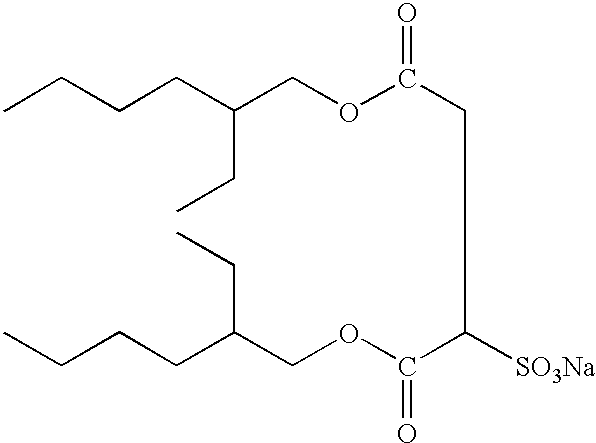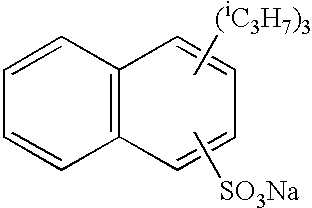Silver halide photographic lightsensitive material
a technology of silver halide and photographic light, applied in the field of photographic lightsensitive materials, can solve the problems of difficult to adsorb dye chromophores in a greater amount, limit the adsorption amount of sensitizing dye on the surface of silver halide grains, and poor sensitivity enhancement
- Summary
- Abstract
- Description
- Claims
- Application Information
AI Technical Summary
Benefits of technology
Problems solved by technology
Method used
Image
Examples
example 1
[0366] (Preparation of Silver Bromide Tabular Emulsion Y)
[0367] 6.4 g of potassium bromide and 6.2 g of a low-molecular-weight gelatin having a weight average molecular weight of 15,000 or less were dissolved in 1.2 lit. of water. While maintaining the temperature of the aqueous solution at 30.degree. C., 8.1 ml of a 16.4% aqueous silver nitrate solution and 7.2 ml of a 23.5% aqueous potassium bromide solution were added thereto over a period of 10 sec by the double jet method. Further, a 11.7% aqueous gelatin solution was added, heated to 75.degree. C., and ripened for 40 min. Thereafter, a 20% aqueous potassium bromide solution and 370 ml of a 32.2% aqueous silver nitrate solution were added over a period of 10 min while maintaining the silver potential at -20 mV. A physical ripening was effected for 1 min, and the temperature was lowered to 35.degree. C. Thus, there were obtained monodispersed pure silver bromide tabular emulsion (specific gravity: 1.15) having an average project...
example 2
[0399] Silver halide emulsions Em-A to Em-O were prepared by the following processes.
[0400] (Preparation of Em-A)
[0401] 1200 mL of an aqueous solution containing 1.0 g of a low-molecular-weight gelatin whose weight average molecular weight was 15,000 and 1.0 g of KBr was vigorously agitated while maintaining the temperature at 35.degree. C. 30 mL of an aqueous solution containing 1.9 g of AgNO.sub.3 and 30 mL of an aqueous solution containing 1.5 g of KBr and 0.7 g of a low-molecular-weight gelatin whose weight average molecular weight was 15,000 were added by the double jet method over a period of 30 sec to thereby effect a nucleation. During the period, KBr excess concentration was held constant. 6 g of KBr was added and heated to 75.degree. C., and the mixture was ripened. After the completion of ripening, 35 g of gelatin succinate was added. The pH was adjusted to 5.5. An aqueous solution of KBr and 150 mL of an aqueous solution containing 30 g of AgNO.sub.3 were added by the do...
example 3
[0551] (Preparation of Emulsion Em-S According to Invention)
[0552] Emulsion Em-S was prepared in the same manner as in the preparation of emulsion Em-B of Example 2, except that the sensitizing dye was changed to D-40 and that the addition amount thereof was 7.0.times.10.sup.-4 mol per mol of silver. The spectral absorption maximum wavelength was 640 nm and the light absorption intensity was 120.
[0553] (Preparation of Emulsion Em-T According to Invention)
[0554] Emulsion Em-T was prepared in the same manner as in the preparation of emulsion Em-F of Example 2, except that the sensitizing dye was changed to D-38 and that the addition amount thereof was 1.0.times.10.sup.-3 mol per mol of silver. The spectral absorption maximum wavelength was 555 nm and the light absorption intensity was 113.
[0555] Samples were prepared by coating cellulose triacetate film supports each having a subbing layer with the emulsions Em-S and -T having undergone the above chemical sensitization, to which the c...
PUM
 Login to View More
Login to View More Abstract
Description
Claims
Application Information
 Login to View More
Login to View More - R&D
- Intellectual Property
- Life Sciences
- Materials
- Tech Scout
- Unparalleled Data Quality
- Higher Quality Content
- 60% Fewer Hallucinations
Browse by: Latest US Patents, China's latest patents, Technical Efficacy Thesaurus, Application Domain, Technology Topic, Popular Technical Reports.
© 2025 PatSnap. All rights reserved.Legal|Privacy policy|Modern Slavery Act Transparency Statement|Sitemap|About US| Contact US: help@patsnap.com



